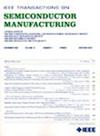Metal Contamination Behavior on Silicon Dioxide Surface Rinsed With Deionized Water Containing Ultra-Trace Metal During Single-Wafer Cleaning
IF 2.3
3区 工程技术
Q2 ENGINEERING, ELECTRICAL & ELECTRONIC
引用次数: 0
Abstract
Metal contamination control in semiconductor manufacturing processes is important because it affects device reliability and yield. The metal contamination control value in deionized water (DIW) is required at the pg/L level for advanced device manufacturing. However, previous studies on metallic contamination proved insufficient owing to their utilization of highly concentrated solutions at a单晶圆清洗过程中含超微量金属的去离子水冲洗二氧化硅表面的金属污染行为
半导体制造过程中的金属污染控制非常重要,因为它会影响器件的可靠性和良率。先进设备制造要求去离子水(DIW)中的金属污染控制值达到pg/L水平。然而,先前对金属污染的研究被证明是不够的,因为他们使用了高浓度的溶液,在$\mu $ g/L的水平上进行批量冲洗。在本研究中,我们研究了在单晶圆清洗过程中,DIW中pg/L水平的金属杂质对二氧化硅(SiO2)表面的污染行为。结果表明,Al、Ti、Fe、Zn和Ga在sio_bb_0 $表面被高度吸附,且这些表面浓度与DIW中的浓度和漂洗时间呈正相关。而这些金属的吸附行为受漂洗液的转速和流速等参数的影响。液固厚度变薄,径向速度增大,吸附概率增大。金属吸附比随附面层厚度的减小而减小。本文为降低DIW中的金属浓度和优化单晶圆清洗过程中的流体参数的针对性提供了新的见解,以防止金属污染,从而提高半导体制造工艺。
本文章由计算机程序翻译,如有差异,请以英文原文为准。
求助全文
约1分钟内获得全文
求助全文
来源期刊

IEEE Transactions on Semiconductor Manufacturing
工程技术-工程:电子与电气
CiteScore
5.20
自引率
11.10%
发文量
101
审稿时长
3.3 months
期刊介绍:
The IEEE Transactions on Semiconductor Manufacturing addresses the challenging problems of manufacturing complex microelectronic components, especially very large scale integrated circuits (VLSI). Manufacturing these products requires precision micropatterning, precise control of materials properties, ultraclean work environments, and complex interactions of chemical, physical, electrical and mechanical processes.
 求助内容:
求助内容: 应助结果提醒方式:
应助结果提醒方式:


